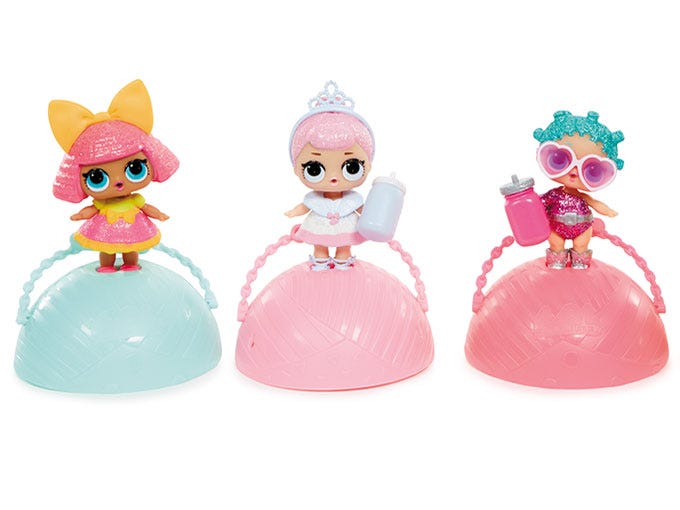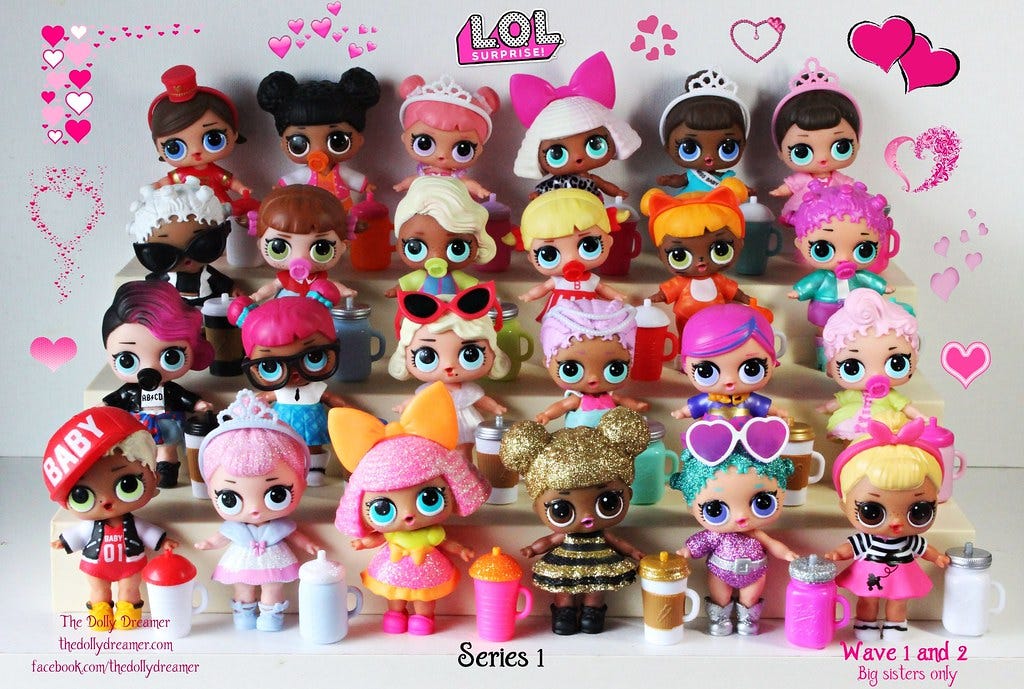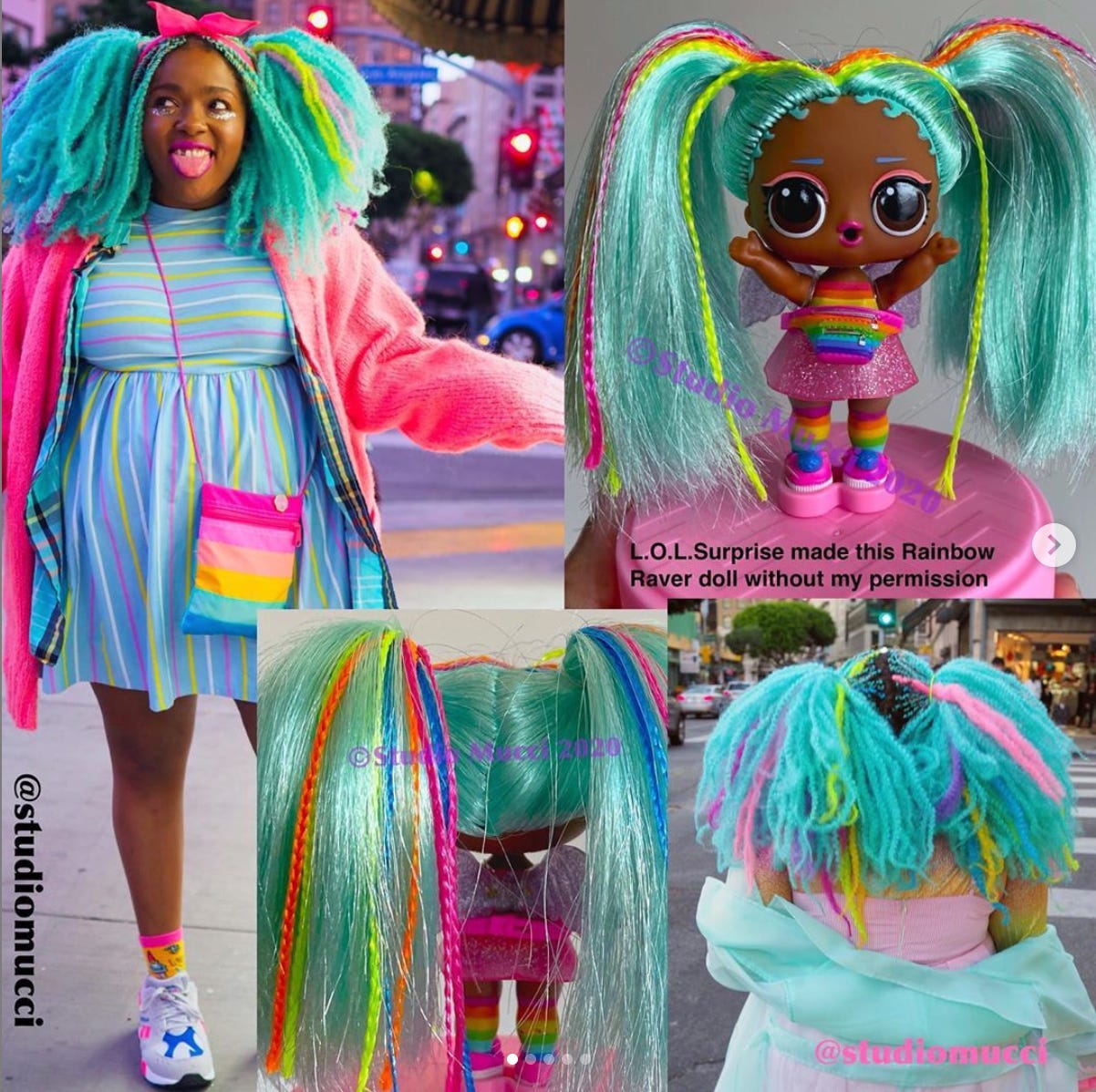"Insane Companies No One Talks About" Episode 2: MGA Entertainment
The privately-owned toy company doing billions in revenue.
Welcome to the second installment of my Substack! (See here for Episode 1 about Sea Limited (NYSE: SE), the publicly traded multi-billion dollar gaming + ecomm company.) I’ve decided my beat is “insane companies no one talks about.” If you have suggestions for succinct/witty names, please send them my way. :)
Today’s post is about MGA Entertainment, the privately-owned multi-billion dollar toy company located just outside of LA on this massive campus:

I’ve become fascinated with MGA over the past few years as I’ve watched them gradually capture the zeitgeist of Gen Alpha (the generation following Gen Z, currently age 10 and under) with “L.O.L Surprise!” dolls.
If you have a daughter between the ages of 4 and 10, you probably know exactly what I’m talking about.
If you don’t, meet L.O.L. Surprise! and the company’s founder, Isaac Larian:

MGA reported that these tiny plastic dolls did $4 billion in revenue in 2018, $5+ billion in 2019, and they projected increased growth in revenue for 2020 (!).
9+ BILLION DOLLARS IN DOLL REVENUE!!!!
OVER JUST A FEW YEARS!!!!
This company’s existence is so completely batshit insane to me, I can hardly wrap my head around it. (For comparison, in 2019 Hasbro reported TOTAL global sales of $4.72 billion and Mattel reported $4.5 billion—MGA is a behemoth in toy world.)
The craziest part is hardly anyone knows about them! Even Larian’s Wikipedia page is pretty sparse, despite his having an estimated net worth of $1.1 billion.
One of the reasons I am so fascinated by MGA, and by the toy industry in general, is that it is largely ignored by investors, makers, and the media. People simply do not take the business of dolls seriously (even though MGA is out here basically printing money lol).
To be a great investor, you have to look where no one else is looking. This is the only way to develop unique insights into what is going to propel the world into the future. For this reason, I figured MGA was worthy of a deep-dive. I’ll go through the company’s major product releases and noteworthy moments below —>
MGA’s History: 1979 - 2020
Isaac Larian was born in Iran and came to the US at 17, enrolling at Cal State LA. He only had a few hundred dollars in his pocket, and he waited tables to make ends meet. After college, he and his brother went into business together.
Their company, which was then called Micro Games of America, became a licensee for a variety of toy products throughout the ‘90s (including Power Rangers, Nintendo, and Hello Kitty).
During this time, Larian realized that the licensee was getting the short end of the stick. So he set out to be the licensor instead—he began building his own IP. In 1997, Larian saw his first major success with Singing Bouncy Baby.
MGA has always been private. Because of this, it’s hard to find exact information on financials. But I can reasonably assume the company was doing pretty well near the end of the 1990s (I’m guessing around $20-$30 million in revenue) because Larian bought out his brother’s shares of the company (~45%) for $9 million in 2000.
In 2001, MGA encountered their first massive success with the launch of Bratz Dolls. In 2006, they acquired Little Tikes (makers of this thing). And in 2016, they launched the one-and-only L.O.L Surprise! dolls.
I’m guessing MGA has been doing $5-6 billion in revenue per year for the last few years, driven almost entirely by LOL dolls. Given that the US toy industry is relatively small (~$27 billion), it’s insane that MGA has captured such a big percentage of market share.
Bratz Dolls
Before we get into LOL dolls, I want to discuss MGA’s first big hit in toy world: Bratz, the fashion-forward (anti-Barbie) dolls that took over the 2000s.
Bratz were the brainchild of Carter Bryant, a toy designer who previously worked on Barbie at Mattel. Bryant had allegedly grown restless with Barbie; he dreamt of creating his own line of dolls that challenged the status quo.
He sketched out four characters, each of whom had a unique personality. He described them as “fearless and strong,” and said he frequently drew them with their hands on their hips in order to convey “just a bit of defiance” (Lobel 13). They had huge heads, large feet, and tiny waists. They wore fashion-forward outfits that represented a distinct move away from Barbie’s prim and proper life.
And thus Bratz, a phenomenon that would one day sweep the nation off its feet, was born:

In 2000, Bryant was introduced to Larian. At that point, MGA was still a relatively up-and-coming toy company. Larian initially did not love the Bratz sketches, saying they looked like aliens. However, his 12 year-old daughter Jasmin was also in the meeting. She was immediately enthralled with the dolls, exclaiming “These are so cool - I need these!”
Larian was sold. Bryant and the rest of the MGA team went to work on the Bratz dolls right away. In 2001, they hit the market for the first time.
The dolls grabbed the world’s attention immediately. People were struck by how rule-breaking they appeared. Girls across the country were hooked, and sales began to take off.

By 2005, Bratz did $1 billion in sales (!!!!). The dolls’ success was heavily impacting Mattel; that year, Barbie sales dropped 13%—one of the most significant decreases in the product’s recent history.
In 2006, a toy industry analyst indicated that Bratz had captured about 40% of the fashion-doll market, compared with Barbie's 60%. By the fourth quarter of 2006, they had overtaken Barbie as #1.
Barbie accounted for about 20% of Mattel’s revenue, and they could not afford to lose the top spot in doll world to Bratz.
Mattel launched My Scene dolls, which, according to Mattel, were “not necessarily something that’s been inspired by the competition at all.”

Mattel also SUED Carter Bryant, claiming that he came up with Bratz while still a full-time employee at Mattel. Separately, Mattel also sued MGA for $1 billion. MGA sued them back, claiming that Mattel was stealing from them and engaging in unfair business practices. The lawsuits went on and on for years, with both parties winning a little here and there… it is estimated that over $600 million was spent in legal fees (!!!!) over the ~10 year legal battle!
If you have extra time, 10/10 I recommend watching this video from the thick of it lmfao. You won’t be disappointed:


Bratz Dolls and ‘90s/’00s Feminism
Bratz dolls represented a major moment in feminism that still resonates with Millennial and older Gen Z women today.
I can remember walking through the mall and seeing them in the store window. I had seen the unforgettably catchy commercial on TV numerous times and was struck by how different they were. They wore trendy teenager clothes, they had huge lips and eyes, loads of makeup… They were everything society told me I should be when I grow up but also everything society told me I should NOT be.
I remember wanting them SO BADLY, but I also remember telling my friends I thought the dolls were stupid because they wore too much makeup and dressed “inappropriately.” (Dear god I hope the next generation of young girls can get some clarity on the female experience bc I’m still so confused tbh.)
Had I had a fully developed brain back then, I would’ve loved Bratz dolls and all they stood for. Barbie was blonde, perfect, had a lame steady bf, and somehow had 10 trillion simultaneous career paths. Bratz, on the other hand, were diverse, high-fashion, defiant, and had specific, consistent interests and goals. Bratz were REAL.
There was no shortage of adults who turned up their nose at Bratz. (“Why would we want to teach our children to act like THIS?!”) The director who made the Bratz live action movie even went on the record with the LA Times in full cringe saying “These aren’t cute dolls–they look like sluts.” (WTF)
In a 2006 interview, the interviewer told Larian that he thought the dolls looked “trashy.” Larian replied:
“They don’t look trashy to me. I think ‘trashy’ is in the eyes of the adults… When you show these to the little girls, and we have done that over and over, everyone says they are beautiful.”
I’m not a parent and I won’t pretend I understand what it’s like to deal with this kind of stuff—But Larian is mostly right, and his capitalization on this was, frankly, genius. A short search of reddit/twitter/youtube comments will show you just how important Bratz was for young women even today:

MGA saw the opportunity in providing young girls with a doll they could see themselves in.
L.O.L. Surprise!
Bratz’s popularity waned over the subsequent years, and revenue appears to be minimal from the late-2000s onwards. At this point, MGA had paid out hundreds of millions of dollars in legal fees for varying degrees of success in the courtroom.
Many doubted that MGA would be able to pull off a second act in the doll industry. But they did—and this time it was MUCH bigger than Bratz.
A YouTube-Native Toy Brand
By 2015, MGA needed another big win. Larian went to his design team and declared:
“We need to make the ultimate unboxing toy.”
Throughout the 2010s, YouTube became the clear winner in kids’ content. This was fueled mostly by “unboxings," a phenomenon where people upload videos of toys being unboxed. These YouTubers have garnered billions of views across the platform, giving rise to massively successful kids’ channels like Ryan’s Toy Review and FunToys Collector Disney Toys Review.
MGA designed the LOL dolls specifically for YouTube:
The dolls are packaged in plastic spheres, which are unwrapped layer by layer in a very satisfying way (perfect for unboxing content)
Each sphere contains a “surprise!” pair of shoes, outfit, accessory, and doll —> you can “collect them all!” and look at the guide to see if your doll is “rare” or maybe even “ultra rare”
Each doll is placed underwater to reveal another “surprise” - a clothing change, a hair change, a tattoo, etc.
Each doll either “cries, spits, or tinkles” when filled with water (????)

Also, I have absolutely no proof for this, but I definitely don’t think it’s an accident that “L.O.L.” and “Surprise!” seem to have incredible SEO if you’re a kid browsing YouTube. (If you look at some of the top kids’ channels, most of the videos have titles like “Disney Elsa LOL OMG! Surprise! Happy! Playtime Elsa Anna Frozen” that simply string together a bunch of keywords.)
The entire L.O.L. Surprise! doll line was designed, from the ground up, to blow up on YouTube - and that is exactly what happened.
When the dolls first hit shelves in 2016, MGA sent the product out to some of the top unboxing channels. They also released a series of stop-motion unboxing videos. In 2017/2018, they launched a new series on their own channel called “LOL Surprise! Unboxed,” a scripted unboxing series featuring recurring actresses Tahani Anderson and Mykal-Michelle Harris. Tahani and Mykal-Michelle unbox the dolls, discuss new releases, chat about their likes and dislikes, and even teach consumers how to tell a “real” LOL doll from a counterfeit one (lmfao).
This series was enormously successful, attracting millions of views per episode over the last few years.
MGA also began licensing out the LOL IP. Today, kids can buy LOL clothing, bedding, lunchboxes, backpacks, etc. LOL is also an extremely popular birthday party theme.
MGA’s YouTube-driven approach propelled the brand into stratospheric success. The dolls did a reported $4 billion in revenue in 2018 and $5+ billion in 2019. We don’t have any reporting on 2020, but revenue was projected to grow YoY. (Anecdotally, it does not feel like the product has declined in popularity.) In 2020, L.O.L. Surprise! won “Toy of the Year” for the third year in a row.
A kids IP tracking study reported that L.O.L Surprise! was the number one girls IP in the US last year, beating Toy Story, Roblox, and The Secret Life of Pets. Pretty crazy for a brand that is only a few years old.

^Source: Smarty Pants Brand Love tracking study
Diversity
Without a doubt, one of the things that made MGA so successful was their focus on diversity. In a world where Barbie reigned supreme for decades, MGA rightfully looked to markets that weren’t being served by the existing toy companies. What is the point of buying a doll if you can’t see yourself in it?
In an early interview about Bratz, Larian says:
“I don’t think an African American girl, or a Middle Eastern ethnic background girl, or a Latin girl… wants to buy necessarily a blonde doll. I think they want to buy something that basically resembles who they are.”
When the first four Bratz dolls were launched, Whiteness was not center stage. Millions of girls across the US finally found a brand where they were the main character. Even today, you can find many Millennial women speaking fondly about their memories of the brand. Many women of color also spoke out praising Bratz for their statement about George Floyd’s death earlier this year:



The diversity strategy is evident with LOL dolls as well. Each doll series features a diverse group of characters:

^ Photo from thedollydreamer.com
Also, MGA primarily hires and features women of color when it comes to both YouTube and Instagram content for the LOL brand.
MGA and Amina Mucciolo
I want to bring attention to an incredibly fucked up incident involving MGA and Black artist Amina Mucciolo.
Mucciolo is known for her colorful, vibrant art. She launched her company Studio Mucci in 2011 and has amassed a large following of over 300k people.
In April 2019, she appeared in an MGA YouTube series about interior design. In July of 2019, MGA released a “Rainbow Raver” LOL doll that looked very similar to Mucciolo (see image below).
After MGA released their Bratz statement on Black Lives Matter nearly a year later, Mucciolo spoke out, saying “… I didn’t have a visual reference or anything, so it was disturbing to see something that came straight from my mind, to be duplicated on a toy that I had no part in creating. Once I was done reeling from the hair, I noticed all of the other similarities.”

^This photo is from her Instagram - read the full context she posted about the issue on her post here.
On her Go Fund Me page for legal fees, she wrote:
“I take a lot of pride in my unique identity and all of the things that make me who I am, and an essential part of that is being Black. So I refuse to be silent while this company who sells toys to children, many of them marketed to young Black girls and POC, behaves this way.
MGA is using this historic fight for Black liberation to sell toys in one breath and then to bash and discredit me in another. All because I tried to highlight that they were guilty of the very injustices done to Black people that they proclaimed to stand against.”
MGA issued a statement denying Mucciolo’s claims. Larian lashed out at her on twitter, calling her a “liar” and “a disgrace to Black people” (WTF). He threatened and insulted her:


He later walked back his statement and deleted his twitter account. There does not appear to be an update in the case at the time of writing this.
You can see Mucciolo’s linktree here for info about how to support her as well as buy her work.
The Business of IP
I would argue that toy companies and media companies are more similar than they are different in that they are all ultimately “IP” companies. If you take a look at Disney and Mattel, for example, their businesses are driven by their winning IP. Mattel even breaks this down in their 10-K by “power brands:”

Entertainment, and specifically IP, is about to enter a really interesting era. Up until recently, IP existed mostly in a linear fashion - we had books and movies with beginnings, middles, and end. Screenwriters followed a traditional 4 Act structure, and there was almost always a beloved hero character.
Today, there is more IP that exists in a transmedia way. Some obvious examples include Marvel and Pokémon. Less obvious examples include the Kardashians, the Hype House, Sesame Street, hit Roblox games, and Miquela. The characters we know and love can live on many platforms concurrently. We familiarize ourselves with these worlds, and we watch narratives play out, to some degree, with our own time and space. Increasingly, we are also able to interact with them on “metaverse” platforms such as Roblox, Fortnite, and Niantic [games].
In the past, toy companies have never done a great job of being “media” companies in the traditional sense. (Ex: Mattel’s Max Steel movie was a flop, as well as the Bratz live-action movie.)
Regardless, all toy companies seem to agree that they are in the business of IP. And if you’re in the business of IP, media like film and YouTube can both establish and enhance a consumer’s ongoing relationship with characters within a universe. Hasbro acquired eOne last year for (presumably) this reason, and Mattel has continued to be persistent in film-related efforts.
MGA’s media efforts for LOL appear to be a bit more strategic. With LOL, they focus primarily on YouTube and social media. In 2019, they created an LOL movie on Amazon Prime, but it was essentially an extension of their YouTube channel (it even featured the same actresses).
Worldbuilding
These “metaverse” platforms are going to become incredibly beneficial for IP with great worldbuilding, and LOL’s worldbuilding has always been on point. The visuals, the color scheme, the characters, the outfits… everything comes together in a vibrant and cohesive way. You know just enough about the characters to identify with them, and yet the world is open-ended enough that you can make it your own through interactivity.
In July of 2020, MGA released this music video for L.O.L. OMG dolls, the “older sister” version of LOL dolls:
I mean what even is this???! The environment art is incredible. The art direction is incredible. The video direction is incredible. The animation is incredible. The song is amazing. I want to LIVE in this low poly neon desert and wear these outfits! (Also, I am a 3D producer and it looks like this was shot using virtual production in Unreal, which is really forward-thinking and cool!)
(Side note: LOL dolls were the subject of a recent QAnon-adjacent conspiracy theory. I won’t explain it here bc I do not want to amplify conspiracies, but basically they latched on to the inappropriate outfits the dolls wear when submerged in cold water as well as the recurring pizza motif in the LOL universe.)
This past July, MGA announced that they had licensed out the LOL IP to create a game that will be exclusively available on Nintendo Switch. Who knows if this will work (it comes down to ownership/execution of creative), but it is a step in the right direction. Why shouldn’t MGA focus on building a digital expansion of the LOL universe? If I were them, I would be sprinting full-force to all the top Roblox developers trying to put together a deal as quickly as possible. I would also try to bring more IP into the LOL world (Ex: why don’t they make a Jojo Siwa LOL doll?).
In Conclusion
I wanted to do a deep dive on MGA because it is an example of a major business success that hardly anyone knows about or pays attention to.
People do not really take kids seriously, and they especially do not take young girls seriously. (How many times have you read articles about how great Fortnite is, with no mention of Roblox? Or about how much money Star Wars has made, with no mention of Hello Kitty?)
Pretty crazy to see the enormous impact of L.O.L. Surprise! on Gen Alpha. It will be interesting to see if it goes on to be a long-lasting brand or if it fizzles in popularity like Bratz.
If you enjoyed this, please follow me on twitter here for more crazy business stories. :)





thank you for sharing about “unreal” I am interested in creating some digital content & possibly some stop motion. :)
This is SO my speed: well-written, super interesting. Loved!